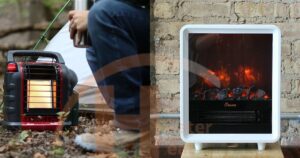Induction cooking, a culinary marvel, relies on electromagnetic fields to generate heat directly within cookware. Unlike traditional methods, it’s a flame-free, energy-efficient approach to transform kitchens worldwide.
Picture a kitchen where pots seem to cook independently, responding to an invisible force. That’s the enchantment of induction cooking. It’s not just a method, it’s a dance of science and flavor, bringing a touch of the extraordinary to your daily cooking routine.
But how does this enchanting process work? Induction stoves use magnetic fields to excite molecules in your cookware, turning them into heat sources. It’s not just efficient; it’s precise and safe, and the future of cooking is already sizzling on your countertop. Let’s unravel the secrets behind this kitchen wizardry.
What is Induction Cooking?
Induction cooking is a culinary innovation that transforms how we approach meal preparation. Unlike traditional stoves that rely on open flames or electric coils, induction cooking harnesses the power of magnetic fields to generate heat directly within your cookware. It’s not just a cooking method; it’s a leap into the future of efficiency and precision.
An induction stove creates an electromagnetic field that excites the molecules in compatible cookware, instantly producing heat. This means faster cooking times, precise temperature control, and a cooler kitchen environment. With no open flames or radiant heat, induction cooking enhances safety and presents a sleek, modern alternative for today’s kitchens.
How does Induction Cooking Work?
Understanding the magic of induction cooking involves exploring the intricate dance between electromagnetic fields and your cookware. The induction stove features a coil beneath its surface that produces a magnetic field when supplied with electricity. When comparing heating methods, such as Electric vs Oil heating, induction cooking stands out for its efficiency and precision. Here’s a closer look at the enchanting process:
- Magnetic Field Interaction: As the induction stove creates a magnetic field, it induces an electric current in compatible ferromagnetic cookware.
- Eddy Currents for Heat Generation: These induced currents create resistance within the cookware, leading to the generation of heat.
- Transfer of Heat: The heat generated is then efficiently transferred to the food, ensuring rapid and precise cooking.
This dance of magnetic forces and currents not only provides a quicker cooking experience but also allows for immediate adjustments in temperature, giving you unparalleled control over your culinary creations.
Is Induction Cooking Safe?

Safety is a paramount concern in the kitchen, and induction cooking steps up to the plate with a range of features ensuring a secure cooking environment. Since the heat is generated directly in the cookware, the induction surface remains cool to the touch, reducing the risk of burns. The absence of open flames minimizes the potential for kitchen accidents.
Induction stoves often come equipped with safety sensors, automatically shutting off when no compatible cookware is detected. This not only conserves energy but adds an extra layer of protection to your kitchen adventures. Embracing induction cooking isn’t just about efficiency; it’s about creating a safer and more enjoyable cooking experience for you.
Basics of Induction
Induction cooking, at its core, revolves around harnessing electromagnetic induction to revolutionize the way we cook. The foundational element of this technology is the induction coil beneath the cooktop’s surface. When electricity flows through this coil, it produces a magnetic field. This magnetic field, in turn, induces an electric current in any compatible ferromagnetic cookware placed on the stove. The exciting aspect of this method is that it directly heats the cookware, allowing for unparalleled efficiency and precision in the kitchen.
The basics also involve recognizing the absence of traditional heating elements like flames or electric coils. Instead, the cookware itself becomes the source of heat, offering a safer and more energy-efficient cooking experience. As we delve into the basics of induction, we open the door to a culinary realm where convenience, speed, and control converge seamlessly.
Explanation of Electromagnetic Induction
Electromagnetic induction is the wizardry behind induction cooking, making it more than just a method—it’s a symphony of scientific principles. When electricity flows through the induction coil, it generates a changing magnetic field. This dynamic field, when introduced to compatible cookware, induces an electric current within it.
This induced current, in turn, creates resistance, resulting in the rapid generation of heat. This elegant process transforms the cookware into a heat source, eliminating the need for intermediary elements like burners or heating coils. The beauty of electromagnetic induction lies in its immediate and precise response.
It enables instantaneous adjustments in temperature, giving you unprecedented control over your cooking. As we grasp the intricacies of this electromagnetic dance, the kitchen transforms into a stage where science meets culinary artistry.
Role of Magnetic Fields in Induction Cooking
In the enchanting world of induction cooking, magnetic fields play a pivotal role in orchestrating the heat transfer process. The induction coil, when energized, produces a magnetic field that permeates the cookware above it. This magnetic field is the catalyst for the induction process, creating a harmonious dance with the ferromagnetic properties of the cookware.
The induction stove relies on the unique ability of ferromagnetic materials—such as iron or steel—to respond to the magnetic field by quickly becoming hot. This direct interaction ensures that the heat is generated precisely where it’s needed, making induction cooking not only efficient but also remarkably safe.
Comparison with Gas and Electric stoves

Let’s unravel the distinctions between induction cooking and its traditional counterparts: gas and electric stoves. While each method has its merits, induction stands out in several key aspects:
- Energy Efficiency: Induction cooking is highly efficient, converting more energy into heat compared to gas and electric stoves.
- Speed: Induction stoves heat up and cool down rapidly, outpacing the response time of both gas and electric alternatives.
- Safety: With no open flames and a cool cooktop surface, induction cooking offers enhanced safety compared to the potential hazards of gas and electric stoves.
- Precision Control: Induction provides precise temperature control, surpassing the precision achievable with gas or electric settings.
- Cleanliness: The flat and smooth surface of induction stoves makes them easier to clean than the burners and coils found in traditional stoves.
In this culinary showdown, induction emerges as a modern and efficient contender, offering a delightful blend of speed, safety, and control that sets it apart from conventional choices.
Components of an Induction Stove
Delving into the heart of induction cooking unveils the intricate components that make it a technological marvel. At the core of an induction stove are three key elements: the induction coil, power electronics, and the user interface. Together, they seamlessly orchestrate the dance of electromagnetic forces, ensuring a cooking experience that is not only efficient but also user-friendly.
Induction Coil
The induction coil serves as the engine of the induction stove, playing a pivotal role in transforming electrical energy into the magnetic fields that drive the entire cooking process. This coil is typically made of copper, a material chosen for its excellent conductivity. When an electric current flows through the coil, it creates a dynamic magnetic field above it, setting the stage for the enchanting interaction with cookware.
The efficiency of the induction coil is a critical factor in the overall performance of the stove. Higher-quality coils ensure a more responsive and powerful cooking experience. As we unravel the intricacies of the induction coil, we gain a deeper appreciation for the engineering precision that powers this culinary magic.
Power Electronics
Beneath the sleek surface of an induction stove lies a sophisticated array of power electronics, responsible for controlling and modulating the electrical energy that courses through the induction coil. These components are the brains behind the operation, regulating the intensity of the magnetic field and, consequently, the heat generated in the cookware.
The efficiency of power electronics is a crucial factor in determining the stove’s performance. Higher-end models often feature advanced electronics that not only enhance cooking precision but also contribute to energy efficiency. Exploring the realm of power electronics in induction stoves takes us into the heart of technology, where smart engineering meets culinary innovation.
Control Panel and User Interface

User interaction with an induction stove is made possible through the control panel and user interface, transforming complex technology into an intuitive and user-friendly experience. This component serves as the bridge between the cook and the culinary possibilities that induction cooking offers.
The control panel typically features touch-sensitive controls, allowing users to adjust temperature settings, activate specific cooking modes, and set timers with a simple tap. The user interface provides visual feedback, ensuring a seamless and enjoyable cooking experience. As we navigate the user interface, we discover how thoughtful design and technological innovation converge to make induction cooking accessible to all, regardless of culinary expertise.
How does the Induction stove work?
Unraveling the magic behind an induction stove involves exploring the fascinating interplay of its key components. At the heart of this culinary marvel are the induction coil, the cookware, and the magnetic field interaction. Let’s embark on a journey through the process that turns your pots and pans into heat sources.
Induction Coil
The induction coil, typically made of copper, is a crucial element in the induction stove. When an electric current passes through the coil, it produces a dynamic magnetic field. This magnetic field is the powerhouse that drives the entire induction cooking process, setting the stage for the enchanting interaction with cookware.
- Efficiency and Performance: The quality of the induction coil directly influences the stove’s responsiveness and power. Higher-end models often boast advanced coils, ensuring a more efficient and precise cooking experience.
- Responsiveness: The induction coil’s ability to generate a magnetic field swiftly and consistently contributes to the stove’s rapid response to temperature adjustments.

Cookware
The cookware used in induction cooking is not your ordinary pots and pans. To harness the magic, the vessels must be made of ferromagnetic materials like iron or steel. These materials respond to the induction stove’s magnetic field by quickly becoming hot, transforming the cookware into the heat source itself.
- Ferromagnetic Compatibility: Induction stoves require cookware with ferromagnetic properties to facilitate the heat transfer process effectively.
- Material Considerations: The choice of cookware material significantly impacts the efficiency and performance of induction cooking, making it essential to opt for pots and pans specifically designed for this method.
Magnetic Field Interaction
As the induction coil generates a magnetic field, it permeates the cookware above it, creating a mesmerizing magnetic dance. This interaction between the magnetic field and the ferromagnetic cookware is the key to inducing the electric currents necessary for heating.
- Invisible Forces: The magnetic field, though unseen, is a powerful force that transforms the cookware into a source of heat.
- Precise Heating: The direct interaction ensures that the heat is generated precisely within the cookware, offering unparalleled control over the cooking process.
Eddy Currents for Heat Generation
The induced magnetic field within the ferromagnetic cookware gives rise to eddy currents—circulating currents of electricity. These eddy currents create resistance within the cookware, converting electrical energy into heat rapidly and efficiently.
- Efficient Energy Conversion: Eddy currents efficiently transform electrical energy into heat, contributing to the overall energy efficiency of induction cooking.
- Rapid Heat Production: The quick generation of heat through eddy currents allows for faster cooking times, adding to the appeal of induction stoves.
Heat Generation
With eddy currents coursing through the ferromagnetic cookware, heat is produced directly within the vessel. This eliminates the need for an intermediary heat source, making induction cooking both efficient and precise.
- Localized Heating: The heat is generated precisely where it’s needed, enhancing the efficiency and speed of the cooking process.
- Immediate Response: The rapid production of heat ensures instant adjustments to temperature settings, providing unprecedented control over the cooking experience.
Transfer of Heat
Once generated, the heat seamlessly transfers from the cookware to the food, promising a swift and efficient cooking experience. This direct heat transfer eliminates the delays associated with traditional methods, contributing to the overall speed of induction cooking.
- Direct Heat Transfer: The absence of intermediate elements ensures that the heat moves directly from the cookware to the food, reducing cooking times.
- Consistent Temperature: The efficient transfer of heat allows for precise control over cooking temperatures, preventing undercooking or overcooking.
Precise Control

Induction cooking offers a level of control that is unparalleled in traditional cooking methods. The instantaneous adjustments in temperature settings and the absence of open flames provide a level of precision that elevates the culinary experience.
- Immediate Temperature Adjustments: The induction stove’s responsiveness allows for quick and precise adjustments, ensuring optimal cooking conditions.
- No Open Flames: The absence of open flames enhances safety and control, giving the cook a heightened sense of command over the cooking process.
Working Mechanism
The intricate working mechanism of an induction stove unfolds like a culinary symphony, harmonizing electromagnetic forces and heat generation without the need for open flames or electric coils. Let’s embark on a journey through the three fundamental stages: the generation of electromagnetic fields, the interaction with ferromagnetic cookware, and the mesmerizing heating process that sets induction cooking apart.
Generation of Electromagnetic Fields
At the core of induction cooking lies the mesmerizing generation of electromagnetic fields. When the induction stove is powered on, an electric current flows through the induction coil beneath the cooktop. This simple yet ingenious process transforms the coil into a source of dynamic magnetic fields. The fluctuating magnetic field extends above the coil, creating an invisible force that permeates the cookware placed on the stove. This dynamic interaction lays the foundation for the enchanting dance of induction cooking.
As the electromagnetic fields oscillate, they induce an electric current within the ferromagnetic cookware. This induced current sets the stage for the subsequent stages of the cooking process, initiating a chain reaction that transforms the cookware into a conductor of heat. The generation of electromagnetic fields serves as the magical overture, orchestrating the symphony of heat transfer that follows.
Interaction with Ferromagnetic Cookware
The induction stove’s magnetic fields come to life as they interact with specially designed ferromagnetic cookware. Unlike traditional pots and pans, these vessels respond to magnetic forces by rapidly becoming hot. The compatibility between the dynamic magnetic field and the ferromagnetic properties of the cookware initiates the induction process, transforming the vessels into active participants in the cooking experience.
This unique interaction is governed by the material composition of the cookware, typically made of iron or steel. As the magnetic field induces an electric current within the cookware, the material responds by generating heat. This direct interaction ensures that the heat is produced precisely where it’s needed, introducing a level of efficiency and control that distinguishes induction cooking from conventional methods.
Heating process without Direct Flame or Electric Coils
One of the marvels of induction cooking lies in its ability to generate heat without the reliance on traditional heating elements like flames or electric coils. As the ferromagnetic cookware responds to the induction stove’s magnetic fields, the cooking vessel itself becomes the source of heat. This unique heating process eliminates the need for intermediary elements, offering a sleek and flame-free cooking experience.
Unlike conventional stoves, where heat is produced externally and transferred to the cookware, induction cooking transforms the pots and pans into active contributors to the cooking process. The absence of open flames not only enhances safety but also contributes to the stove’s energy efficiency. The heating process in induction cooking is a direct and precise orchestration of magnetic forces, turning your cookware into a culinary stage where the magic of heat unfolds.
Power consumption of an Induction stove

Understanding the power consumption of an induction stove unveils the efficiency and precision that characterize this modern cooking technology. The power rating, variable power levels, and the concept of less power loss collectively contribute to making induction stoves not only energy-efficient but also customizable to meet the diverse needs of different cooking tasks.
Power Rating
The power rating of an induction stove is a crucial factor that influences its overall performance. This rating is typically measured in watts and indicates the maximum amount of power the stove can draw. Higher power ratings generally signify a stove’s ability to generate more heat rapidly, making it suitable for a range of cooking techniques, from gentle simmering to rapid boiling.
The power rating also aligns with the size of the induction coil, directly impacting the stove’s responsiveness. High-end induction stoves often feature precise power control, allowing users to adjust the intensity of the heat with accuracy. Understanding the power rating provides cooks with the knowledge needed to select an induction stove that matches their specific cooking requirements, ensuring optimal efficiency and performance in the kitchen.
Variable Power Levels
One of the standout features of induction stoves is their ability to offer variable power levels. This flexibility allows users to customize the intensity of the heat based on the specific demands of each cooking task. Induction stoves typically come equipped with a control panel that allows users to adjust power levels with precision, providing instant changes in temperature as needed.
Variable power levels contribute to the efficiency of induction cooking by enabling a rapid response to adjustments. Whether you’re looking to bring a pot to a gentle simmer or achieve a rapid boil, the ability to tailor the power level ensures that the stove adapts to the cook’s requirements, offering unparalleled control over the cooking process.
Less Power Loss
In the realm of energy efficiency, induction stoves shine by minimizing power loss during the cooking process. Unlike traditional cooking methods that may experience significant heat dissipation, induction stoves focus on directing heat precisely where it’s needed—within the cookware. This targeted approach translates to less wasted energy and a more eco-friendly cooking experience.
The reduction in power loss not only contributes to the overall efficiency of induction stoves but also aligns with a broader commitment to sustainability. The cookware’s direct response to the magnetic fields ensures that energy is harnessed efficiently, delivering precise and rapid heat without unnecessary waste.
Advantages of Induction Stoves

Induction stoves have swiftly become the darlings of modern kitchens, offering a slew of advantages that redefine the cooking experience. Let’s explore these perks, from energy efficiency to faster cooking times and a range of safety features.
Induction stoves, with their sleek design and cutting-edge technology, bring a new level of efficiency and precision to the kitchen. Here’s a glimpse of what makes them stand out:
- Energy Efficiency: Induction stoves boast impressive energy efficiency by directly transferring heat to the cookware, minimizing wasted energy.
- Faster Cooking Times: The rapid response of induction stoves means quicker heating, reducing overall cooking times, and getting meals on the table faster.
- Safety Features: With advanced safety measures, induction stoves create a secure cooking environment, making them an ideal choice for households.
Energy Efficiency
At the forefront of induction stove advantages is their exceptional energy efficiency. Unlike traditional stoves where heat is generated externally and then transferred to cookware, induction stoves create heat directly within the pots and pans. This targeted approach minimizes energy loss, ensuring that the majority of the energy drawn is converted into heat for cooking.
The efficiency is further accentuated by the stove’s ability to adjust power levels instantly. When you lower the heat, the induction stove responds immediately, preventing unnecessary energy consumption. This efficiency not only contributes to environmental sustainability but also results in lower energy bills for users, making induction stoves a smart and economical choice.
Faster Cooking Times
Induction stoves are renowned for their speed in heating cookware and, consequently, reducing overall cooking times. The rapid response of the electromagnetic fields means that the cookware heats up swiftly, allowing for immediate adjustments in temperature settings. Whether you’re boiling water, searing meats, or simmering sauces, the quick and precise heating of induction stoves streamlines the cooking process.
This advantage is particularly valuable for busy individuals or families, as it means less time spent in the kitchen and more time enjoying delicious meals. The faster cooking times also contribute to the overall energy efficiency of induction stoves, as less time is required to reach and maintain the desired cooking temperatures.
Safety Features
Induction stoves prioritize safety with a range of features that make them a secure choice for home kitchens. The absence of open flames and the cool-to-the-touch cooktop surface significantly reduce the risk of burns and accidents. Here are some key safety features:
- Cool Cooktop Surface: The induction stove’s surface remains cool during operation, minimizing the risk of burns.
- Automatic Shut-off: Many induction stoves are equipped with sensors that automatically shut off the heat when no compatible cookware is detected, preventing energy wastage.
- Child Lock: A child lock feature ensures that the stove settings remain unchanged, preventing accidental adjustments by curious little hands.
- Pan Detection: Induction stoves often have pan detection technology, activating the heat only when compatible cookware is placed on the surface.
- Overheat Protection: Sensors monitor the temperature, automatically shutting off the stove if it exceeds safe levels, enhancing overall safety in the kitchen.
These safety features collectively make induction stoves not only efficient and speedy but also a secure choice for households, providing peace of mind while cooking.
Limitations and Challenges

While induction stoves bring a plethora of benefits to the kitchen, they do come with certain limitations and challenges that users should be aware of. Two significant aspects to consider are the compatibility of cookware materials and the initial cost and installation considerations.
Compatibility with Cookware Materials
One of the primary limitations of induction stoves lies in the requirement for specific cookware materials. To effectively utilize the induction process, cookware must have ferromagnetic properties, typically found in materials like iron or steel. Traditional aluminum, copper, or glass cookware won’t interact with the magnetic fields, rendering them incompatible with induction stoves.
While many manufacturers now produce induction-compatible cookware, users might find themselves needing to invest in new pots and pans when transitioning to induction cooking. This initial adjustment can be a consideration for those with an existing collection of non-compatible cookware. However, as the popularity of induction stoves grows, the availability of suitable cookware options also continues to expand, mitigating this limitation over time.
Initial Cost and Installation

Another aspect to weigh is the initial cost and installation considerations associated with induction stoves. Compared to conventional gas or electric stoves, induction models often come with a higher upfront price tag. This can be a potential barrier for budget-conscious consumers.
The installation process may require specific electrical requirements, such as a dedicated circuit. Homes without existing wiring compatible with induction stoves might incur additional costs for electrical upgrades. Despite these initial considerations, it’s important to recognize that the long-term benefits, including energy savings and improved cooking efficiency, can offset the initial investment.
To provide a clearer overview, here’s a concise table outlining the key considerations for compatibility and installation:
| Consideration | Description |
| Cookware Compatibility | Induction stoves require ferromagnetic cookware for efficient operation, potentially necessitating an investment in new pots and pans. |
| Initial Cost | Induction stoves generally come with a higher upfront cost compared to traditional gas or electric stoves. |
| Installation Considerations | Specific electrical requirements may be necessary for installation, potentially requiring upgrades to existing wiring. |
Understanding and addressing these limitations during the decision-making process ensures a smoother transition to induction cooking, allowing users to maximize the benefits while navigating potential challenges.
Environmental Impact

Exploring the environmental impact of induction stoves reveals a story of energy efficiency and a reduced carbon footprint. When compared to traditional cooking methods, induction stoves showcase a compelling commitment to sustainability and responsible energy consumption.
Energy Efficiency and Reduced Carbon Footprint
Induction stoves are recognized for their exceptional energy efficiency, translating to a reduced carbon footprint. The direct transfer of heat to cookware minimizes energy wastage, ensuring that the majority of the electricity consumed is converted into useful cooking energy. This efficiency is further enhanced by the stove’s ability to precisely control power levels, responding instantly to adjustments and preventing unnecessary energy consumption.
Reducing the carbon footprint is a critical aspect of environmental sustainability, and induction stoves play a pivotal role in achieving this goal. As energy-efficient appliances, they contribute to lower overall energy consumption, subsequently decreasing greenhouse gas emissions associated with electricity generation. This dual commitment to efficiency and sustainability positions induction stoves as eco-friendly alternatives, aligning with the global imperative to reduce our environmental impact.
Comparison with other Cooking Methods
When compared to conventional cooking methods, induction stoves emerge as environmentally conscious choices. Let’s briefly explore how induction stoves stack up against gas and electric stoves in terms of their environmental impact:
| Consideration | Induction Stoves | Gas Stoves | Electric Stoves |
| Energy Efficiency | Highly efficient, minimizing wastage | Combustion may result in heat loss | Generally less efficient due to heat loss |
| Carbon Footprint | Reduced due to lower energy consumption | May contribute to higher emissions | Emissions depend on electricity sources |
| Environmental Impact | Lower overall impact | Combustion processes can release pollutants | Emissions may vary based on energy sources |
Induction stoves shine in terms of energy efficiency and a reduced carbon footprint, presenting a sustainable choice for environmentally conscious consumers. This comparison underscores the positive contribution that induction stoves make to the broader goal of minimizing the environmental impact of household activities.
Conclusion
the induction stove stands as a technological marvel, transforming the way we approach cooking with its efficiency, precision, and environmental considerations. As we navigate the intricate workings of electromagnetic fields and induction coils, it becomes evident that this innovation is not merely a cooking method but a harmonious blend of science and culinary artistry.
The advantages of induction stoves, from energy efficiency to faster cooking times and advanced safety features, position them as leading contenders in the modern kitchen landscape. Their ability to directly transfer heat to ferromagnetic cookware not only ensures rapid and precise cooking but also contributes to a substantial reduction in energy wastage, exemplifying a commitment to sustainability.
While acknowledging the limitations, such as cookware compatibility and initial costs, it’s crucial to recognize the long-term benefits that induction stoves offer. The shift towards a more sustainable kitchen ecosystem, with a reduced carbon footprint and heightened energy efficiency, aligns with global efforts towards a greener future. In the grand finale of this induction cooking journey, we find not just a kitchen appliance but a transformative force.
The induction stove, with its sleek design and eco-friendly credentials, emerges as a symbol of culinary innovation, offering a delightful blend of efficiency, precision, and environmental responsibility for households worldwide. As we bid adieu to traditional cooking methods, the induction stove remains at the forefront of a culinary revolution, inviting us to embrace a future where sustainability and flavor dance together on the kitchen stage.
Frequently Asked Questions
Can I use any Cookware on an Induction Stove?
No, induction stoves require cookware with ferromagnetic properties like iron or steel for efficient heat transfer.
Do Induction Stoves have Safety Features?
Yes, they often include safety features like automatic shut-off, child lock, and cool cooktop surfaces for enhanced kitchen safety.
How do Induction Stoves compare in terms of Cooking Speed?
Induction stoves are known for faster cooking times due to their immediate response to temperature adjustments.
Are Induction Stoves more Expensive than Traditional Stoves?
Yes, induction stoves typically have a higher initial cost, but the long-term energy savings can offset the upfront investment.
Are Induction Stoves Energy-Efficient Compared to Gas or Electric Stoves?
Yes, induction stoves are highly energy-efficient, minimizing wasted energy and reducing overall environmental impact.

Mark Edward, with 6 years of expertise in Electric Heaters, is the author at heaterheat.com. His in-depth knowledge provides valuable insights into efficient heating solutions, making him a trusted resource.











